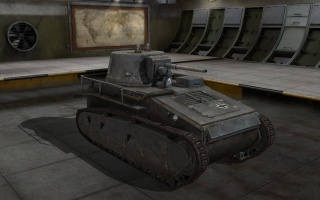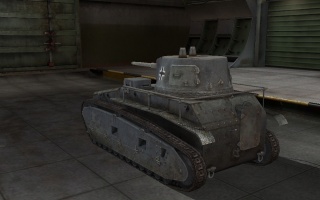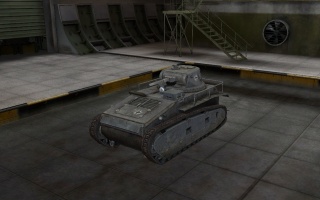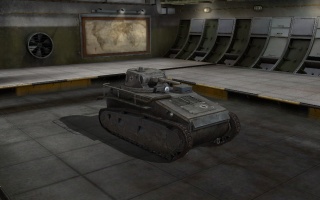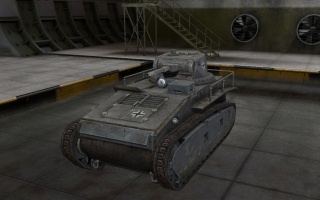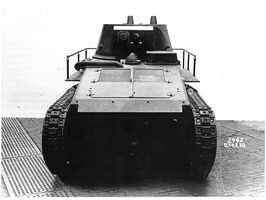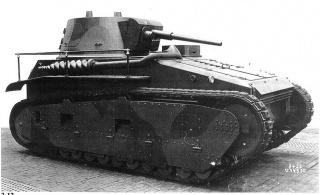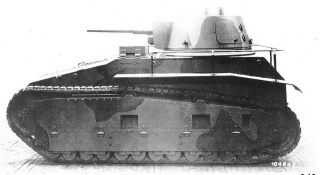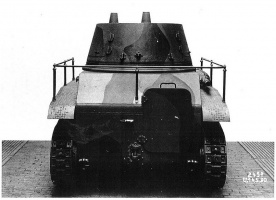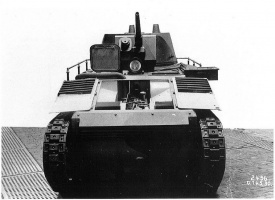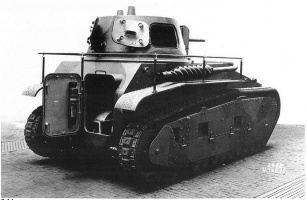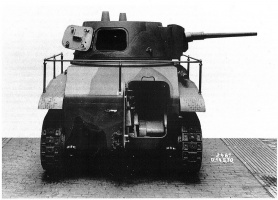Leichttraktor
| Revision as of 21:05, 8 March 2013 | Revision as of 08:57, 24 March 2013 It has 310m. Others 280m and 260m which could be useful. | |||
| Line 7: | Line 7: | |||
| * Stock gun is decent | * Stock gun is decent | |||
| * 2cm Breda has good reload, penetration and damage | * 2cm Breda has good reload, penetration and damage | |||
| + | * Best view range of tier 1 | |||
| |InTheGame_cons= | |InTheGame_cons= | |||
Revision as of 08:57, 24 March 2013
<value_unset_error>
Mouse over "
[Client Values; Actual values in
| 0 |
| health Hit Points |
| 0/0Expression error: Unexpected < operator./Expression error: Unrecognized word "unable". t Weight Limit |
| engine Engine Power |
| / km/h Speed Limit |
| traverse Traverse |
| Expression error: Unexpected < operator.Expression error: Unexpected < operator. hp/t Power/Wt Ratio |
| NoNo Pivot |
| // mm Hull Armor |
| //Unable to match configuration for query: turret:ltraktor::top|armorturretfront/Unable to match configuration for query: turret:ltraktor::top|armorturretside/Unable to match configuration for query: turret:ltraktor::top|armorturretback mm Turret Armor |
0/0/0
0/0/0 Shell Cost |
| //Unable to match configuration for query: gun:ltraktor::top|damage1/Unable to match configuration for query: gun:ltraktor::top|damage2/Unable to match configuration for query: gun:ltraktor::top|damage3 HP Damage |
| //Unable to match configuration for query: gun:ltraktor::top|penetration1/Unable to match configuration for query: gun:ltraktor::top|penetration2/Unable to match configuration for query: gun:ltraktor::top|penetration3 mm Penetration |
|
Expression error: Unrecognized word "unable". r/m ▲
Expression error: Unrecognized word "unable". r/m Magazine-fed Gun ▲ Rate of Fire Magazine-fed Gun |
|
Expression error: Unrecognized word "unable". ▲
Magazine-fed Gun
▼
Magazine-fed Gun
▲
Expression error: Unrecognized word "unable". Magazine-fed Gun
▲
Magazine-fed Gun
▼
Magazine-fed Gun
▲ Damage Per Minute Magazine-fed Gun
|
|
Expression error: Unrecognized word "unable". m ▲
Expression error: Unrecognized word "unable". m With 50% Crew: Expression error: Unexpected < operator. m ▲ Accuracy With 50% Crew: Expression error: Unexpected < operator. m |
|
Expression error: Unrecognized word "unable". s ▲
Expression error: Unrecognized word "unable". s With 50% Crew: Expression error: Unexpected < operator. s ▲ Aim time With 50% Crew: Expression error: Unexpected < operator. s |
| Unable to match configuration for query: turret:ltraktor::stock|turrettraverseUnable to match configuration for query: turret:ltraktor::top|turrettraverse deg/s Turret Traverse |
| 0° Gun Arc |
| -°/+°-Unable to match configuration for query: gun:ltraktor::top|depression°/+Unable to match configuration for query: gun:ltraktor::top|elevation° Elevation Arc |
| Unable to match configuration for query: gun:ltraktor::stock|maxammoUnable to match configuration for query: gun:ltraktor::top|maxammo rounds Ammo Capacity |
| Expression error: Unrecognized word "unable".Expression error: Unrecognized word "unable". % Chance of Fire |
|
Unable to match configuration for query: turret:ltraktor::stock|viewrange m ▲
Unable to match configuration for query: turret:ltraktor::top|viewrange m With 50% Crew: Expression error: Unexpected < operator. m ▲ View Range With 50% Crew: Expression error: Unexpected < operator. m |
|
Unable to match configuration for query: radio:ltraktor::stock|distance m ▲
Unable to match configuration for query: radio:ltraktor::top|distance m With 50% Crew: Expression error: Unexpected < operator. m ▲ Signal Range With 50% Crew: Expression error: Unexpected < operator. m |
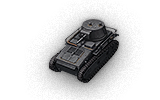
0
The <value_unset_error> is a [[|]] tier .
<value_unset_error>
The first German tank available to the player, the Leichttraktor starts with an underpowered 50hp engine and the 3.7 cm KwK 36 L/46.5, although this can be quickly upgraded. Adequate armor and performance characteristics make it a very good starting tank. The tank is nicknamed "LoLTraktor" and is the basis of a fan-made comic series.
The <value_unset_error> marks the end of its line.
Modules / Available Equipment and Consumables
Player Opinion
Pros and Cons
Pros:
- Good hit points
- Good traverse speed
- Stock gun is decent
- 2cm Breda has good reload, penetration and damage
- Best view range of tier 1
Cons:
- Poor damage
- Front mounted engine
- Poor top speed with the first engine
Performance
It's armor is in between the thickness of the MS-1 and T1 Cunningham, thick enough to bounce shots and yet light enough to keep the tank at a weight of 7 tons. Stock, it is equipped with an underpowered 50 horsepower engine, making the tank slow and unwieldy. However, this can be quickly upgraded to an 85 and 100 horsepower engine, giving it a large boost in speed and taking it up to par with it's tier 1 counterpart. It is equipped with the a 37mm gun at first, with high penetration and relatively good accuracy for a tier I gun. When upgraded, it trades penetration for a high rate of fire as the gun shifts from the 37mm gun to the lighter 20mm auto-cannons, with high damage per minute in exchange for low penetration values. Adequate armor and performance characteristics make it a very good starting tank. The only main weakness of the Leichttraktor is it's huge front crew hatches, which is nearly unprotected and can be easily hit by enemy fire. The engine is located at the front, meaning that it is extremely easy to knock it out or light it ablaze from a direct frontal hit. Having a turret towards the back of the tank, the Leichttraktor can be very surprising when attacking from behind a corner, because the turret is placed in the rear.
The Leichttraktor is much more maneuverable when fully upgraded, but nothing can be done about the large silhouette. If you prefer the 37mm gun, then you will fare better with the PzKpfw 35 (t), while if you prefer the auto-cannons, the PzKpfw II will be the best choice.
Please note the Map Restrictions for tier 1 tanks if you consider purchasing a camouflage skin/paint job for this tank.
Early Research
- The Krupp M311 engine is a good place to start on this tank.
- The 2 cm Breda is the highest penetrating auto-cannon available to any of the tier 1 tanks.
- Go from there.
Suggested Equipment
Gallery
Historical Info
After the First World War, Germany was restricted in military development by the Versailles Treaty, but a secret program under the cover name "traktor" tested and developed armored military vehicles and artillery.
Testing Grounds
image:Rapallo Treaty 1922.jpg|Rapallo Treaty (1922) The German-Soviet treaty from Rapallo signed in 1922 and the Berlin Friendship Treaty of 1924 allowed Germany to test their designs in the Soviet Union under high security and secrecy. The testing facility used from 1926 to 1933 was called Panzertruppenschule Kama, and was located near Kazan in the USSR. The location was a joint military testing ground and tank school for the Red Army and the Reichswehr. It was codenamed Kama from the two words kazan and malbrandt. Oberstleutenant Malbrandt was assigned to select the location for testing.
Requirements
The secret motorization program (Kraftfhr Ruestungsprogramm), dated 17 April 1928, ordered the delivery of the first trial pieces (Versuchsstuecke) for October 1929 in order to begin testing in 1930. Additionally, beginning in 1931, a company of 17 vehicles at a cost of 50,000 Marks per Kleintraktor was acquired.
Inspecktorat 6 (K) (In 6) in the Wehramt prepared basic functional characteristics for a light tank. These functional requirements were then given to Heereswaffenamt Pfuefwesen 6 for trial pieces (Versuchssteucke). Waffenpruefwesen 6 (Wa Prw 6) then created conceptual guidelines and technical specifications to provide a basis for detailed designs, and awarded development contracts to design companies. The design contractors prepared overview drawings and general descriptions of their proposed design. The proposals were reviewed and changed by Wa Prw 6 and In 6 (K) prior to awarding development contracts. The requesting organization controlled the funding, in this case, In 6 (K). In 6 (K), development and procurement programs for new combat vehicles were approved as line items in the annual budget for overall military expenditures. Development of a light tank was initiated on 14 March 1928, under the program codename "Kleintraktor", later renamed "Leichttraktor".
Preliminary requirements (25 April 1928) at a meeting between the representatives of the Wehramt and prospective developers outlined the basic need for a fully-tracked vehicle with a fully-rotating turret, which should be equipped with a semi-automatic 37mm gun and one auxiliary 7.92mm light machine gun. The vehicle should be equipped with an engine that has an output of at least 60hp.
image:Leichttraktor Photo.jpg|Leichttraktor Further specifications and changes were spelled out on 25 May and 10 June 1928, and the project name changed from "Kleintraktor" to "Leichttraktor". The project required the development of a multipurpose platform, which should not only form the chassis of a battle tank, but also a ration supply vehicle (Verflegungsnachshub), ammunition transport (Munitionstransport), and industrial applications vehicle (Wirtshaft).
Weapons were to consist of a semi-automatic 37mm cannon housed together with a light machine-gun in a fully-rotating turret. The ammunition supply was to be a minimum of 150 rounds for the cannon and 3000 rounds for the machine-gun. The crew were to consist of four members: a gunner (Kampfwagen-Schuetze), commander (Kampfwagen-Kommandante), driver (Fahrer), and radio operator (Funker).
Armor was designed to resist S.m.K. steel core armor-penetrating rifle shells, and important equipment was to be protected against 13mm cannon shells. Front and side armor had thicknesses of 14mm. Road speed was to be around 25-30 km/h, and soft-ground speed to be 20km/h. The Leichttraktor was to carry 150 liters of fuel and have a range of 150 km or 6 hours of operation time. The vehicle was to be able to climb a 60% (31°) pitch for no less than a 1 km stretch with a speed of at least 3 km/h, as well as climb a step and ford a river depth of 60 centimeters. Additionally, the tank was to cross trenches of 1.5 meters in depth and have a ground clearance of 30 centimeters. The specific ground pressure was to be a maximum of 0.5 kg/cm^2.
The vehicle was to be equipped with a radio (with telegraph key) (Funk-Telegraphie-Geraet) with a stationary range of 3 km, a mobile radio range of 2 km, and a Morse code range of 17 km. Additionally, the vehicle needed to have a smoke dispensing device (Vernebelungspapparat) with the ability to dispense smoke for 20 minutes, and a poison gas filter (Gasfilter). Finally, the design was not to exceed 7.5 tons in weight.
Preliminary Design
The first designs were based on the lessons learned from the development of the Leichte Kampfwagen I and II (LK I and LK II) (1918-1919), which only existed as prototypes.
image:Leichttraktor Krupp 1930 Diag.jpg|Leichttraktor Krupp 1930 Krupp prepared preliminary drawings very quickly (preliminary drawings were dated 3 July 1928). Besides the tank design, Krupp also proposed a platform for commercial and civilian applications called Leicht Zugmaschine (LZ). The platform would be able to be equipped with plows, winches, and could serve as a truck. One of the proposals was for a transport vehicle that would be able to transport 15 people, including the driver. A modification for an artillery spotting vehicle (Beobachtungswagen) was also proposed. This variant had no turret, but had a fully-armored superstructure and retractable observation instruments. This modification was also proposed as an ambulance, whose crew would consist of two drivers, a physician, and two assistants. A self-propelled gun was also designed with a 7.5cm field gun, but its ultimate production was considered unlikely as the vehicle had very limited space for the crew and ammo.
Krupp had to choose between the 100hp Maybach engine or the 15/70/100hp Daimler engine with injectors. The Maybach engine was quieter because of its lower speed (1900rpm versus Daimler's 2800rpm) but was significantly larger and weighed more (400kg versus Daimler's 362kg). The Maybach was also more expensive, but more fuel efficient. In the end, the Daimler engine was selected for the design as it would keep the engine compartment smaller.
| Full weight(with crew): | 6000kg |
|---|---|
| Length: | 3900mm |
| Width: | 1850mm |
| Height: | 2000mm |
| Engine: | 100hp |
| Speed: | 4-40km/h |
| Climb | 65% |
| Track width: | 250mm |
| Track contact: | 2x2500mm |
| Ground Pressure: | 0.48kg/cm2 |
| Ground Clearance: | 300mm |
| Step: | 600mm |
| Ford: | 800mm |
| Trench: | 1400mm |
| Fuel: | 150liters |
| Armor: | 14mm |
In the designs, the engine was positioned in the front with cooling on the right, and was protected by an armored grate; fuel and steering were on the left. The engine had a starter magneto and an electrical generator. If the starter failed, the engine could be started using a crank. Cooling was provided by twin fans with an engine-driven belt. A Krupp 4-speed, 3-ton, truck transmission with a 2-speed transfer case provides eight forward and two reverse gears.
image:Leichttraktor Rheinmetall Leichttraktor 1930.jpg|Lecihttraktor Rheinmetall (1930) image:Leichttraktor Rheinmetall cog 1931 Diag.jpg|Lecihttraktor Rheinmetall (1931) A drive shaft with two universal joints connected the transfer case to the rear drive housing that, with the aid of a differential and two spur gears, transferred power to the rear track drive-wheels. For steering and braking, there were two brake drums with Cletrac auxiliary wheels on both sides of the differential, which help slow the track when the brake is applied.
Two rubber tracks (Gummiraupen) were used. Later experimentation with cable or transfers would decide which type to implement. 2x3 road wheel pairs were mounted on each side that, with swinging arms and springs, were designed to provide a soft suspension for driving on roads and crossing obstacles. An additional fixed road wheel was located below the idler wheel and provided the track with good support while crossing obstacles. Both idler wheels were adjustable, and had spring tensioners to prevent the track from breaking when driving over obstacles. The track returned forward over a track box and two support rollers. The track box itself was bolted to the hull and served to hold the springs and to stow equipment.
image:Leichttraktor Krupp cog 1931.jpg|Leichttraktor Krupp (1931) The driver would sit on the left and have vision slits (optical glass) in an armored head-housing (Kopfgehause). The 3.7cm Geschütz-Turm was mounted on the roof of the armored hull behind the driver. The gunner (Richtkanonier), commander (Kommandant), and loader (Landekanonier) sat in the turret. 150 rounds of 3.7cm ammunition were stowed in armored panniers to the left and right, between the tracks. Three 20 rounds were stowed in removable holders, and two 15 rounds were stowed horizontally in individual packing. The ammunition for the machine gun was stowed under the floor plates and in the track boxes, where the smoke dispensers were also located.
The radio operator (Funker) sat close to the floor to the right and somewhat behind the driver. The radio sender and receiver sat directly in front of him. An 80amp-hour battery for vehicle lighting and air filtration was located on the floor directly behind the driver. The air filter was mounted on the rear access hatch, and the hatch was sealed with a rubber gasket.
A firewall in the instrument panel for the driver completely sealed the engine compartment from the rest of the hull, allowing positive-pressure to be maintained in the crew compartment by the filter. Due to the high mounting of the cooling system, the vehicle was able to ford rivers up to 80cm deep.
After review by Wa Prw 6, the 80/100hp, 6 cylinder/7 liter Daimler-Benz Lkw.-Motor Type M36 was favored because it was able to achieve 50hp at 800rpms to 100hp at 1900rpms, with a maximum torque of 45 mkg @ 600-1200rpm. It was also decided that a 3-speed Friedrichshafen-Soden-Getriebe with claw shifting was be installed with a Krupp auxiliary gear instead of the Stroboskop. An observation cupola (Beoboachtungskuppel) with protective glass (Kinonglass) was also decided to be used.
Contracts
On 16 June 1928, Oberstlt Gaissert (head of Wa Prw 6) sent a letter to Fried. Krupp A.G.,Abt. A.K., Essen, Rheinmetall, Duesseldorf, Daimler-Benz, z.Hd., and Dr. Porsche, Stuttgart-Unterturkheim, with a proposed contract between the Heereswaffenamt and the firms for the design and production of two Klien-Traktoren.
image:Leichttraktor Rheinmetall assembled chassis front 1930.jpg|Leichttraktor Rheinmetall assembled chassis (1930) image:Leichttraktor Rheinmetall assembled chassis side 1930.jpg|Leichttraktor Rheinmetall assembled chassis (1930) Krupp agreed, and the contract was signed between Generalmajor Buchholz from Heereswaffenamt(15 October 1928) and Herr Hageloch from Krupp (24 October 1928). However, Krupp's contract stated they would not include parts of military nature, consisting of the armament, 14mm thick armor, and additional technical equipment. Carbon-steel was to be used for the hull and a fixed price of 230,000 Goldmark was established for the contract/construction of two prototypes. Rheinmetall also accepted the contract for two prototypes, as well as the secret development of the armaments for all four prototypes. In July 1928, Daimler-Benz emphatically declined the specific development contract, but would draw up the prototype for the supply vehicle (Nachschubfahrzeug).
Krupp, in cooperation with Rheinmetall-Borsig, began work on the four contracted prototypes. Both Krupp's and Rheinmetall's 4-man prototypes were powered by a 6-cylinder, 100hp, Daimler-Benz M36 truck engine and were were very similar in design, the main difference being the type of suspension: Krupp used coil springs and Rheinmetall used leaf springs. Both vehicles were known as Leichttraktors (VK 31) and were armed with a 37mm KwK L/45 with a -10/+30 degree vertical movement and a light machine-gun on a rear-mounted turret (designed and produced by Swedish AB Landsverk and Bofors).
The Rheinmetall-designed Leichttraktor (L.Tr.Rhm) differs from Krupp's in that: 1) the fuel tanks were located in the track boxes; 2) the driver and radio man could sit beside the engine, allowing a better view and access to the engine; 3) the hull bottom was reinforced with ribs; 4) the use of a heavy-duty model 4-speed Soden transmission, assembled with the transfer case (with two short shift levers on top of the lid); 5) final drives for the track-drive wheels were located outside the hull; and 6) large brake drums for brake bands were mounted on the inside of the hull side. Additionally, there was a hatch in the hull rear-wall, a hatch above the radio operator, and a hinged rectangular vision cupola (Sehkuppel) above the driver. Kinonglas-blocks were mounted behind vision slits on three sides of the Sehkuppel. The width of these vision slits could be adjusted from 3 to 20 mm wide by sliding the adjustable plates. The weight of the Sehkuppel was counterbalanced by the coil spring.
Preliminary tests at Krupp (without turret, which was to be assembled by Rhienmetal) proved to be a huge success. In 6 (K) and Wa Prw 6 were very pleased with the speed and maneuverability of the vehicle, and expressed special thanks to Krupp for such good service.
All four prototypes were finally assembled in the Rheinmetall facilities in Unterluess because Rheinmetall was also responsible for all four turrets.
Testing
image:Leichttraktor Krupp Russia Photo.jpg|Leichttraktor Krupp in Russia image:Leichttraktor Rheinmetall Leichttraktor expr suspension mod 1933.jpg|Leichttraktor Rheinmetall experimental suspension mod (1933) The prototypes were ready in May of 1930. Four prototypes were built: two from Krupp and two from Rheinmetall. Rheinmetall-Borsig also produced a third prototype, an early Panzerjager, which was a three-man self-propelled mild-steel mount for a 37mm PaK L/45 gun.
All four prototypes were sent to Russia for testing. The Leichttraktors by Krupp were designated Nr.37 and Nr.38, and those by Rheinmetall as Nrs.39 and Nrs.40. The prototypes arrived at the Kana testing grounds in June 1930. Overall, the Leichttraktor vehicles were considered a success during testing and were subsequently used for training in Kama, but were not seen as fully-ready for combat.
image:Leichttraktor Krupp radiator shield photo.jpg|Leichttraktor Krupp with Reinforced Radiator In 1930, based on the testing at Kama, the radiator was strengthened and the Soden transmission was replaced with an Aphon one. The Leichttraktors were converted to dry steering brakes, the driving brakes were modified, the suspension was strengthened, and the drive wheels were replaced with harder ones. Cables were replaced with hydraulically-actuated steering brakes. Daimler modified the Nachshub-Fahrzeug suspension to nine double road wheels, a 2575mm track contact length (weight increasd to 8400kg), and the Krupp Leichttraktor had spring suspension installed.
In 1932, Rheinmetall widened its Leichttraktor's twelve double road wheels from 86 to 90mm. Later, one was experimentally modified with four large diameter road wheels with spring suspension.
image:Leichttraktor Rheinmetall Leichttraktor 40 suspension mod 1932.jpg|Leichttraktor Rheinmetall Nr.40 suspension mod (1932) image:Leichttraktor Krupp 38 1933 photo.jpg|Leichttraktor Krupp Nr.38 (1933)
Conclusion
image:Leichttraktor Krupp suspension mod 1932 Diag.jpg|Leichttraktor Krupp suspention mod (1932) image:Leichttraktor Rheinmetall interior MG.jpg|Lecihttraktor Rheinmetall interior image:Leichttraktor Rheinmetall interior A.jpg|Leichttraktor Rheinmetall interior Testing at Kama showed that the position of the machine gun, as well as the limited diameter of the turret ring, made loading the main gun more difficult and slower. Additionally, the gunner had to take command of the tank in certain situations. This lowered the rate of fire, made the commander redundant, and ultimately lowered the efficiency of the entire crew. As a result, it was concluded that the commander needed to be in the main turret as per the original design, and that in the future, a 12-hour clock needed to be used to communicate between the commander and the gunner. Also, it was absolutely necessary for the turret to be both electrically and hand-driven.
Deflector and spent cartridge sacks proved useful for both the machine gun and the cannon, as the crew was not hindered by the spent propellent gasses, even though the hatches were always open for safety at Kama. No experience was gained in the question of riveted versus welded steel, as the turret was not made of armored-steel but of normal steel.
In 1931, 289 units were ordered, but in 1932, the project was canceled in favor of other developments, such as the Panzerkampfwagen I. Together, Krupp and Rheinmetall produced only 4 prototypes. In 1933, cooperation between the Soviet Union and Germany ended and all four vehicles were returned to Germany.
| 1930 | 1931 | 1932 | total | |
|---|---|---|---|---|
| Nr.37 | 365 | 697 | 598 | 1660 |
| Nr.38 | 534 | 371 | 1095 | 1800 |
| Nr.39 | 382 | 708 | 775 | 1865 |
| Nr.40 | 290 | 513 | 932 | 1735 |
Upon returning to Germany in 1933, the Leichttraktors were sent to Heereszeugamt Spandau for overhaul. Further tests took place in the summer of 1933. During the winters of 1934 and 1935, they were stored near Berlin. In the summer of 1935, all four Leichttraktors took part in major maneuvers at the troop training grounds (Truppenuebungsplatz Munster Lager) to test the concept of Panzerdivision. The Leichttraktors were then transferred to the newly established Tank Gunnery School (Panzerschiessschule Putlos) near Oldenburg/Holstein, where they were used to train crews for several more years. The tanks were continuously modified to aid in testing new designs for future light tank development.
image:Leichttraktor Rheinmetall Leichttraktor expr suspension mod 1933 B.jpg|Leichttraktor Rheinmetall with exiremental suspention (1933) image:Leichttraktor Krupp measurements 1931 Diag.jpg|Leichttraktor Krupp measurements (1931) image:Leichttraktor Rheinmetall Leichttraktor measurements 1932.jpg|Leighttraktor Rheinmetall measurements (1932)
Model | Number Built | Armament in turret | 3.7cm ammunition | M.G. ammunition | Armor (carbon steel) | Crew | Engine | Horsepower | Power to weight ratio | Maximum speed (km/h) | Fuel capacity | Range (km) | Transmission | Steering | Length (m) | Width (m) | Height (m) | Wheelbase (m) | Total Weight (metric tons) | Roadwheels per side | Pairing | Number of support points | Roadwheel diameter | Roadwheel width | Track Type | Track Width (mm) | Track Pitch (mm) | Track Links per side | Track length (m) | Track contact length (m) | Support length (m) | Ground Pressure (kg/cm2) | Ground Clearance (mm) |
|---|---|---|---|---|---|---|---|---|---|---|---|---|---|---|---|---|---|---|---|---|---|---|---|---|---|---|---|---|---|---|---|---|---|
| L. Tr. Kp. | 2 | 3.7cm 1 s.M.G. | 150 | 3000 | 5-14mm | 4 | M36 Daimler 4-cyl 7.8 liter | 100 | 11.5 hp/t | 30 | 220 | 137 | 4-speed | Cletrac | 4.350 | 2.370 | 2.350 | 1.810 | 8.7 | 9 | 2-4-2-1 | 4 | 400,260,300 | 95 | Dry Pin | 266 | 130 | 72 | 9.360 | 2.565 | 1.850 | 0.73 | 305 |
| L. Tr. Rhm. | 2 | 3.7cm 1 s.M.G. | 150 | 3000 | 5-14mm | 4 | M36 Daimler 4-cyl 7.8 liter | 100 | 11.2/t | 30 | 220 | 137 | 4-speed | Cletrac | 4.320 | 2.260 | 2.270 | 1.800 | 8.96 | 12 | 3x4 | 3 | 210 | 85 | Bearing | 270 | 130 | 72 | 9.360 | 2.720 | 1.980 | 0.71 | 290 |
Historical Gallery
Sources and External Links
| Light Tanks | |
| Medium Tanks | |
| Heavy Tanks | |
| Tank Destroyers | |
| Self-Propelled Artillery |
| USA | |
| UK | |
| Germany | |
| France | |
| USSR | |
| China | |
| Japan | |
| Czechoslovakia | |
| Sweden | |
| Italy | |
| Poland |





